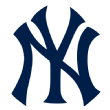Which 2018 playoff team is most likely to miss out this year?

Two offseasons ago, I wrote a column asking which 2016 playoff team was least likely to make the postseason in 2017. I picked the Toronto Blue Jays. I was right! The Blue Jays fell from 89 wins to 76 and missed the playoffs.
If I remember correctly, my reasoning focused on the age of a Toronto lineup that dropped from 891 runs scored in 2015 to 759 in 2016 and looked vulnerable in 2017 (when the Blue Jays scored 693 runs). The Blue Jays did not have the biggest drop in wins of the 2016 playoff teams, though. The Baltimore Orioles fell 14 wins, the Texas Rangers and New York Mets both dipped 17 wins and the San Francisco Giants declined a whopping 23 wins, from 87 to 64.
My editors have asked me to revisit this idea, and the question seems especially pertinent this offseason, given the slow-moving action in free agency has resulted in a lot of criticism levied toward teams that have remained quiet. Of the teams that won fewer than 80 games last season, only the Cincinnati Reds and Mets have displayed much desire to try to improve through trades and/or free agency.
One thing I wanted to know: Is a playoff team more likely to have made the playoffs the previous season or more likely to miss the playoffs the following season? I went back to 1996, the first full season of the wild-card era. This gives us 198 teams to look at.
50.0 percent (99 of 198)
51.6 percent (97 of 188)
Of course, the addition of the second wild card in 2012 added a fifth playoff team per league to the mix. Let's see how that changes the numbers.
Made the playoffs the previous season: 50.0 percent (64 of 128)
Made the playoffs the following season: 50.8 percent (65 of 128)
Made the playoffs the previous season: 50.0 percent (35 of 70)
Made the playoffs the following season: 53.3 percent (32 of 60)
In theory, the addition of the second wild card was supposed to create more incentive for teams to push for the playoffs, also resulting in more turnover in the postseason from year to year. Instead, we've seen the same 50 percent turnover rate. That would suggest five of our 10 playoff teams from 2018 won't make it this upcoming season.
I do wonder, however: If fewer teams are "going for it" these days, do playoff windows last longer? Let's look at each playoff team's three-year window and see how many teams made it to the playoffs all three seasons:
28.9 percent (37 of 128)
25.0 percent (15 of 60)
It's a smaller sample size, but no real change -- although it's worth noting that seven of 2018's 10 playoff teams also made the playoffs in 2017 and thus have the chance to make the playoffs in every season of their three-year window. (In 2017, five of 10 teams were playoff repeaters. It also was five of 10 in 2016.)
A couple of baseball's greatest dynasties dominated the 1996-2011 era: The New York Yankees made the playoffs every season from 1995 to 2007, while the Atlanta Braves made it every campaign from 1995 to 2005. Those two franchises account for 20 of the 37 three-year runs. The longest current playoff run belongs to the Los Angeles Dodgers, at six seasons in a row (all division titles). The Chicago Cubs are at four, while the Boston Red Sox and Cleveland Indians sit at three.
There might be better ways to look at this, but while we seemingly have had a long list of rebuilding teams recently, this study is a reminder that there always are bad franchises. Perhaps the difference is that some of today's rebuilding teams have arrived there by choice as opposed to the mere incompetence that might have ruled in the past.
Anyway, the Red Sox, Yankees, Indians andHouston Astrosare strong favorites to return to the postseason, even as we wait for rosters to finalize. If there is playoff turnover in 2019, it's more likely to come from a crowded National League playoff picture. Let's rank last year's 10 playoff teams, from least likely to miss the playoffs to most likely:
The American League is so top heavy and the Yankees' lineup so deep that it's almost impossible to imagine a scenario where they miss the playoffs, even if their starting pitching falls apart. If that does happen, Aaron Boone can simply ride the best bullpen in the majors. Throw in some likely better numbers from Aaron Judge, Giancarlo Stanton and Gary Sanchez and the Yankees look more than capable of topping last year's 100 wins.
The advantage the Astros have over the Yankees and Red Sox is that Houston doesn't have them as division opponents. Yes, the Oakland Athletics won 97 games last season, but do you see that happening again? That means the Astros should cruise to another division title. The Astros do have a few questions to sort out in the rotation -- don't discount the possibility of Dallas Keuchel returning -- but the lineup is imposing, and the additions of Michael Brantley and top prospect Kyle Tucker make it even better.
I rate the Red Sox behind the Yankees and Astros for a few reasons: Boston's bullpen isn't as good; there are some concerns over Chris Sale's shoulder; the possibility of a World Series hangover; and a weak minor league system. Still, if Mookie Betts and J.D. Martinez hit close to their 2018 levels, you can print playoff tickets.
There is a strong case that the Dodgers are the best bet to return to the playoffs. After all, they've won all those NL West titles in a row, they're still loaded with more rotation depth than any other team, they added A.J. Pollock and they have Corey Seager returning. Plus, the division looks weak, as theGiants andSan Diego Padreshave been quiet so far, and theArizona Diamondbackslost their two best players in Paul Goldschmidt (trade) and Patrick Corbin (free agency), along with Pollock. The non-playoff scenario features a strong season from theColorado Rockies, a couple of major injuries and a tight wild-card race that results in the Dodgers falling short.
Maybe the most frustrating comment from a front-office executive this offseason came over the weekend from Minnesota Twins general manager Thad Levine at the team's TwinsFest. Asked about Manny Machado and Bryce Harper, Levine answered: "My view ... for doing it is the best time to acquire players of that magnitude is when your window to win is wide-open. Not when you've got your fingers underneath the window and you're trying to jam the window open. I want to do it when we're projected to win the Central and we're ready to put our foot on someone's throat."
So, don't sign a star ... unless you're already expected to win the division?
Not that Machado and Harper want to sign with the Twins, but no team could benefit from adding a player of that magnitude more than the Twins, who are trying to chase down Cleveland. The extra wins a player such as Machado or Harper could provide might be the difference between first place and second place -- not to mention that they could add that foot to the throat for future seasons.
The Indians are somewhat vulnerable, with a weak outfield, a weak bullpen and not much offense after Jose Ramirez and Francisco Lindor; if they suffer a major injury in the rotation, they're even more susceptible. The Twins have some strong rebound candidates, and the other three teams in the division are bad. Minnesota did add Nelson Cruz and Jonathan Schoop, but imagine Machado or Harper anchoring its lineup.
The Cubs are good. A lot went wrong in 2018 and they still won 95 games. There are concerns with the rotation (Jon Lester and Cole Hamelsare both 35, Yu Darvish is coming off an injury, Tyler Chatwood is coming off a 5.30 ERA), but the main thing that could get in their way is a strong division. The St. Louis Cardinals look tougher with Goldschmidt, and the Reds should be better. The NL Central teams could beat each other up to the point that only the division winner makes the playoffs.
NL Central current projections via FanGraphs:
Cubs: 87-75
Cardinals: 86-76
Reds: 81-81
Pirates: 80-82
Brewers: 79-83
So, that's interesting. I think the Brewers are better than that and the projections are likely underestimating their bullpen and defense. I also like what Corbin Burnes and/or Brandon Woodruff could do in the rotation. Still, it's a tough division and some players might not repeat their 2018 performances, making the Brewers a regression candidate.
The Braves added Josh Donaldson, but the Mets andWashington Nationalsalso have made significant additions, and the Philadelphia Phillies could still land Machado or Harper on top of Andrew McCutchen and David Robertson. The Braves also lost Anibal Sanchez (2.83 ERA in 24 starts), and we'll see if Mike Foltynewicz can repeat his BABIP-heavy 2.85 ERA. Basically, it looks like a four-way slugfest in the NL East, which makes the Braves vulnerable.
The biggest advantage the A's have for a return to the playoffs is a lack of competition. The Tampa Bay Rays should be playoff contenders after winning 90 games, and maybe the Twins step up. But the Seattle Mariners won't be as good, and the Los Angeles Angels made just minor additions to an 80-win team. The A's just signed Marco Estrada, and rookie Jesus Luzardo could make an impact; however, the rotation looks shaky, the bullpen will probably regress and you have to figure one of the Rays, Twins or Angels will put it together. That could block the A's from a wild card.
The Rockies hold the same advantage that the Dodgers have of playing in a weak division, but all Colorado has done is add Daniel Murphy (while losing DJ LeMahieu). The Rockies' rotation was outstanding in 2018 -- and also healthy, with four starters making 31 or more starts. That's unlikely to happen again, and not just because of altitude. Mostly though, the Rockies will simply face tougher competition across the league. With the Dodgers rating as heavy favorites in the division, the Rockies are thrown into that crowded wild-card free-for-all.














